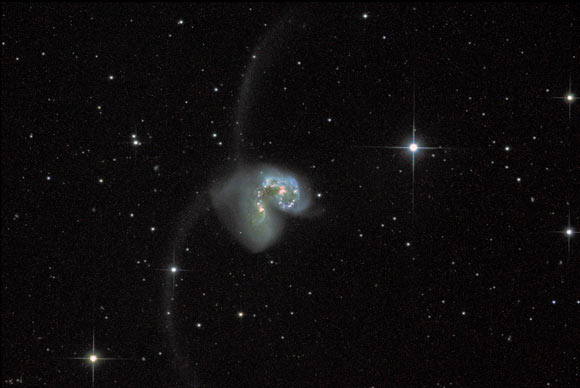The Superpressure Balloon-borne Imaging Telescope (SuperBIT) — a collaboration between Durham University, the University of Toronto, Princeton University, and NASA — was launched on a scientific super pressure balloon on April 16, 2023, from Wānaka, New Zealand.

This image of the Tarantula Nebula was taken by the Super Pressure Balloon Imaging Telescope (SuperBIT). Image credit: NASA / SuperBIT.
SuperBIT is a 0.5-m, wide-field, diffraction-limited balloon-borne telescope that operates within the stratosphere — at 33.5 km altitude, above 99.5% of the Earth’s atmosphere — in order to achieve space-like operating conditions and performance.
Carried by seasonally stable winds, the telescope will circumnavigate the southern hemisphere several times on its three-month flight — imaging the sky all night, then using solar panels to recharge its batteries during the day.
SuperBIT costs about £4.1million/$5million USD, almost 1,000 times less than an equivalent satellite.
With optical sensitivity from the near-infrared (900 nm) to the near-ultraviolet (300 nm), SuperBIT aims to make precise weak gravitational lensing measurements of galaxy clusters in order to infer the presence and relative quantity of dark matter in these clusters as well as the large scale structure of the Universe.
To achieve high precision measurements from a balloon-borne environment, the SuperBIT gondola stabilizes its telescope to sub-arcsecond precision (akin to a three degree-of-freedom Steadicam) while sophisticated optics further stabilize the SuperBIT camera to less than 50 milli-arcseconds.
“The science goal for SuperBIT’s first flight is to measure the properties of dark matter, a heavy but invisible type of material,” the SuperBIT astronomers said.
“Although dark matter is invisible, the telescope will map where it is by the way it bends passing rays of light, a technique known as gravitational lensing.”
“SuperBIT will test whether dark matter particles can bounce off each other, by mapping the dark matter around clusters of galaxies that happen to be colliding with their neighbors.”
“Various theories about dark matter suggest that, during a collision, some dark matter might either slow down, spread out, or get chipped off.”
“If we can map dark matter leaving the collision, we could finally start to learn what it’s made from.”
SuperBIT has already taken its first images on this flight, showing the Tarantula Nebula and the collision between the Antennae Galaxies.
“The Tarantula Nebula is a large star-forming region of ionized hydrogen gas that lies 161,000 light-years from Earth in the Large Magellanic Cloud,” the astronomers said.
“Its turbulent clouds of gas and dust appear to swirl between the region’s bright, newly formed stars.”
“The Antennae Galaxies, cataloged as NGC 4038 and NGC 4039, are two large galaxies colliding 60 million light-years away toward the southerly constellation of Corvus.”








